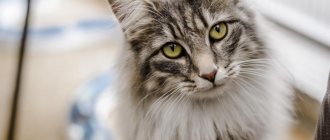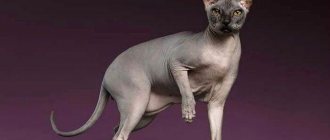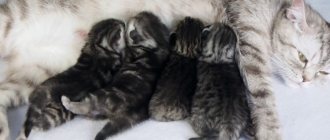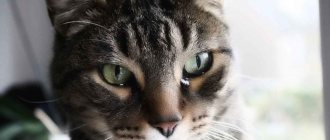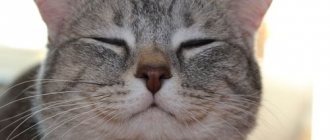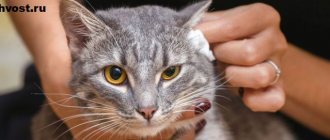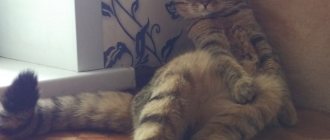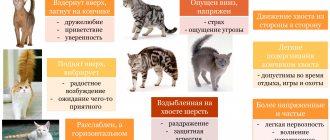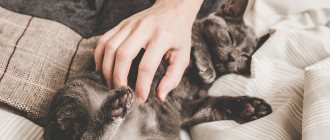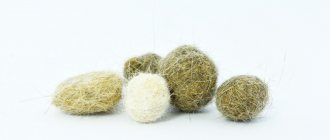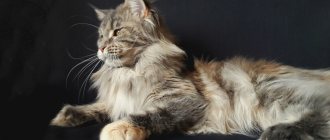If there's one thing cats love more than anything else, it's sleep. An adult feline can sleep from twelve to sixteen hours a day, and kittens up to six months old can sleep up to twenty hours. It turns out that cats sleep for two thirds of their lives! You can find your cat on the window, in your bed, in the closet, on the countertop, even under the sofa. As long as she feels protected, she will sleep anywhere, even if you think it is the most uncomfortable place on the planet. But what does the furry pose mean? It turns out that you can say a lot about it too.
Covering your nose with your paws
Have you ever noticed how your cat covers her face or head with her paws when she sleeps? There are several reasons why animals may prefer this position. If their paws are covering their eyes, they may be blocking the sun or bright light in the room, or trying to keep their nose warm.
If they cover their head, it means they don't want to be disturbed. When cats hide their heads, they feel safe and protected, sending a signal that they want to be alone. If you notice that your pet is sleeping in this position, it is better to leave him and not wake him.
Belly up
In this position, the cat sleeps on its back and spreads its paws. When cats bare their bellies, they are letting the world know that they feel safe and happy in their surroundings. The stomach is considered the most vulnerable part of the body, and by leaving it unprotected, the cat is sure that it is not in any danger.
What offense did Alexandra Ursulyak not forgive her first husband and filed for divorce?
We’re making a cute curtain for a child’s room with eyelets: pieces of different fabric will come in handy
Seychelles opened borders: entry rules for Russians
Belly up is the most vulnerable position in all animals. If your cat bares it, it's a sign that she trusts you and feels safe in her home. You can be proud that you have created the most suitable conditions for your purr.
My cat likes to lie on her back. What does it mean?
Contents hide
My cat likes to lie on her back. What does it mean?
Do you like to watch funny pictures on the Internet from the life of pets, in particular cats? Take a closer look at how many owners have photographed their furry pets in funny poses - lying on their backs, legs spread out limply! Has it ever occurred to you that maybe the cat sends some signals to its owners in such a bizarre way? Maybe there's something wrong with her?
Your cat is just happy. First, let's try to reassure fans of these wonderful animals! In the vast majority of cases, the cat lies on its back, wanting to show how happily it lives in your home, how calm it is, and feels completely safe. Some experts believe that in this way, individual cats demonstrate obedience to their owners - they say, I admit: you are the owner, and I am your pet. To finally make sure of the happiness of your furry friend, take a closer look and listen. Does your cat like to sleep on its back? Great! And if she is not sleeping, then lying on her back, what is she doing? Purrs and quietly spreads its claws? Congratulations – everything is in perfect order in your home!
But that's not all. Some cats, showing their bellies, show - come on, play with me! Does the pussy have an interested muzzle and its ears raised? The situation is hopeless: take a toy and join the game.
Finally, here's another reason: your pet is ready to reproduce. Cats especially often lie on their backs during an interesting period.
Reasons to think! Things are not always as rosy as we just noted. Sometimes the “lying on its back” position is defensive for the cat, especially if it is internally tense. Don't forget - the cat is a predator; being in this position, she can easily attack with all four paws, and in addition use her sharp teeth. Look at your pet's ears - if they are folded, then be on your guard! Pay attention to the pupils: they are dilated, which means the animal is ready to attack. Most often, with all this, you will hear a dull growl or a dissatisfied rumbling. Then try not to go too far and move away in time!
Some tips. Of course, a vigilant and observant owner always knows his pet better than we, who give owners only some average advice. When working with a kitten, and later with an adult cat, always pay close attention to his body language. Always try to clearly differentiate positive signs from negative ones. Sometimes extra caution is required, even if the cat seems to be purring in a relaxed manner. Give the animal as much attention as possible! After all, this is the main key to your mutual trust!
Original publication: What Does It Mean When a Cat Lies on Its Back? Author: Jay Matthews Source and photo:
Curled up in a ball
When cats curl into a crescent shape, wrap their tail around their body, and lower their head to their chest, it means they are protecting themselves from potential danger. This is an instinctive position that allows cats to stay warm while protecting vulnerable body parts. This is one of the most common sleeping positions for cats.
If your cat sleeps in this position, she almost certainly wants to be left alone. There is no need to try to wake the animal or start playing with it, it is better to just let the cat rest peacefully. When she gets enough sleep, she will be grateful for your care and will begin to actively express it.
Cat communication
Cats communicate using posture, movement, voice and smell. Their language is universal. A cat from Greece will perfectly understand a cat from Canada. Apparently there are no cats that "speak" with an accent.
Body language Eyes Ears Tail Scent glands
Purring Paw kneading and drooling Sounds Table Gestures
Language of the body
Agile, agile, muscular, flexible, with an athletic build - all these words can be applied to healthy cats. Cats use their bodies extremely expressively. They might be masters of speech restraint. If a cat sits with its back to you, it means that it is telling you exactly what you think: “not now, not here and not with you.” If a cat is lounging in front of you, it means she feels free and self-confident. If she has rolled over onto her back, she may be in a relaxed, playful and trusting frame of mind. However, you should not rely on this. A cat lying on its back may also be in a defensive position. Even a good-natured cat can start biting and scratching if you rub its belly. For many cats, this is an instinctive reaction.
In general, if a cat tries to appear larger than it really is by arching its back and bristling its fur, it means it is defending itself. Cats tend to turn sideways towards their attacker to make themselves look as big as possible. The cat is scared, she tries to look threatening and will fight if she is forced to do so.
If a cat tries to appear smaller than nature intended, lies down, lowers its head, presses its ears and whiskers, does not bristle its fur, presses its tail to its body and, perhaps, waves it, touching the ground, it means that it is scared and hopes that no one will notice it. . She will defend herself intensely if forced, but would prefer "to be left alone."
A cat crouched on the ground, half-prostrate, usually emitting a long, low growl, holding its tail close to its body or waving it from side to side, is aggressive. Her ears are usually directed forward or upward, and her mustache bristles. This cat is ready and able to fend for itself, so don't force it to do so.
Eyes
The eyes are truly the window to the soul, and this is especially true for cats. Cats do not mislead anyone and with their gaze they will make it absolutely clear to you what they think about you.
If your cat looks at you for a few seconds, blinks, and then turns away, it means she is acknowledging you, but not inviting you to interact. This is the cat equivalent of the brief nod you might use to greet someone on the street. This hardly means an invitation to a long conversation, but at the same time it is not a manifestation of rudeness.
A long, persistent look most likely means a threat. This look has universal meaning, whether a stranger is looking at you on the street or a cat is doing it. This is a warning.
A cat who is on friendly terms with you may make prolonged eye contact with you in a gentle manner, and then such a look will not mean anything bad. To understand a cat's motives, you should read its entire body language in certain situations.
The pupils of your eyes will tell you more. If the pupils are dilated, it means they are screaming in fear. If you don't know for sure whether your cat is afraid or not, look at her pupils. Wide eyes and dilated pupils mean that something scary is approaching. In an aggressive cat, the pupils can turn into slits, as narrow as possible.
Ears
Cats' ears are much more mobile than ours. They are shaped to capture even the slightest sound. Cats have much more acute hearing than we do.
Because cats' ears are so visible and mobile, cats use them to communicate with each other. Some cats even have tufts of hair at the tips of their ears that act like flags, making the “language” their ears speak even more understandable.
Having ears pointing up can mean curiosity, joy, playfulness, relaxation, but whatever it is, it's always a good sign. An exception may be some aggressive cats, whose upward-pointing ears convey self-confidence rather than friendliness.
If the ears are directed to the sides, this is a sign of fear, mistrust or self-defense - it all depends on the characteristics of the particular cat and the situation. If your cat is upset, respect these signs and give her a wide berth.
If the ears are directed back and pressed against the head, it indicates panic, aggression or attack. Either way, this is a red stop light for you. Warning! Retreat if at all possible, or be prepared to pay the consequences.
Tail
If you can read what a cat's tail is telling you, you will know very well what your cat is thinking.
The tail can be ceremonial, pointing straight up. In this case, it is used to demonstrate self-confidence and pride. Cats that hold their tails like this walk in an important, pompous manner.
Fear can make the tail resemble a bottle brush. If the tail is fluffy and seems larger than its natural size, this means a mixture of feigned courage and fear. Never try to adopt a scared cat - she won't appreciate it, and neither will you.
Slow tail flicks indicate mild irritation. Such irritation may be the result of interrupted sound sleep or unwanted stroking. Many cats want to be close to you, but they don't want you to pet them all the time. Watch closely and don't miss those slow tail flicks. They tell you: "Enough!"
Quick swishes of the tail raised upward are a joyful greeting, while the cat rubs against its legs, meows and purrs, rejoicing at your return home.
Sometimes the tip of the cat's tail twitches sharply. She makes such movements when she looks out the window at a bird or prepares to throw herself at a toy. The longer she looks, the faster her tail twitches, until finally it begins to sway vigorously from side to side across its entire length.
Scent glands
Your cat uses scent to mark its territory. Fortunately for you, apart from the smell of cat urine, all the other smells she uses to mark objects are indistinguishable to the relatively primitive human sense of smell.
Your cat probably scent-marks you on a daily basis, although you may not be aware of it. In cats, scent glands are located on the lips, chin and forehead. Therefore, cats mark this or that thing with their scent when they rub their lips and muzzle against it. The joyful greeting with which a cat greets you when you walk through the door, when she wraps herself around your legs, rubs against them and purrs, cuddling up to you, really only means that she is marking you with a scent so that everyone can immediately understand: “ My! This man is mine, mine, mine! That's why they do this when they see us after a long day of being away or when we leave a room or enter a house from the street. Our cats mark us by happily rubbing their heads against us every morning, as part of their daily greeting ritual. We like it. Perhaps cats think that we also mark them with scent when we pet them.
Scratching is another common way for cats to mark objects with scent. They have scent glands on their paw pads, and they effectively scent-mark objects by running their paws over them. This is why even cats whose claws are trimmed still continue to scratch things.
There is another way that cats use to scent-mark objects: with their urine. For people, this method is the most unpleasant. The urine of an adult, unneutered cat seems to have the most disgusting smell in the world. This smell is amazingly persistent. You can thoroughly clean the area, and still on a warm, humid day, that musty smell will haunt you.
Purring
Purring is a more mysterious process than you might think. It is generally believed that cats purr when they are happy. This is true, but this is not the only condition under which they purr. It happens that cats purr when they experience terrible pain at this time.
Purring is like a runny nose. Almost everyone has had to deal with it, and yet we do not have a clear enough understanding of this phenomenon. But perhaps it doesn't matter: both cats and their owners know exactly what purring means. These are the minutes they spend with each other in complete harmony. This means reaching out in the middle of the night with your hand to your best friend who is always there. This is when a cat's head lovingly pokes a sad person's chin. Whatever it means, cats certainly express bliss in this way. There is no doubt that this is the most wonderful sound a cat makes.
Kneading with paws and drooling
The habit of kneading various objects with its paws dates back to the time when a kitten sucked its mother's milk and kneaded her nipples with its paws in order to squeeze out milk from there. This behavior expresses extreme pleasure and is often accompanied by purring and drooling. Drooling is a relic of the Pavlovian conditioned reflex associated with suckling mother's milk.
Sounds
The cat uses its voice masterfully. The normal vocal range is 750-1520 Hz. Cats pronounce about 15 simple sounds - seven of them are consonants: M, N, G, X, F, V, R. By changing the duration, pitch, timbre, cats can say a lot to someone who understands them.
Cats make sounds for a variety of reasons, some more often than others. A typical sound that cats often make is a short, soft meow, similar to the happy chirping that cats make when they see you coming. Schweika does this when she trots across the room to greet me. These are joyful sounds.
There is another type of meow that can be expressed by saying, “I want something.” These are more demanding, louder and longer sounds than the welcoming chirp. Most cat owners hear this sound when it's time to eat, when the cat is sitting near the door, or when she is locked in a room where she no longer wants to be.
The longest sound a cat makes means: “I hate you!” This is a cross between a growl and a squeal that cats make when they are scared or angry. Usually such a sound is addressed to another cat - an uninvited guest, or a fearsome dog. It is a tense, high-pitched sound in the throat, reminiscent of a siren. As soon as you hear it, you will immediately recognize it.
The most wonderful sound that can be heard from cats is snorting and purring. These joyful high-pitched sounds mean: “Oh, is that you? Glad to see you!" Cats reserve these sounds only for their closest friends.
When cats look at prey they can't catch, they make rapid sounds that sound like "keh-keh-keh." Usually people don't hear them. However, if you have a window with a bird feeder, and your cat is sitting at that window, watching the birds, but can't get to them, you have a chance to hear this sound. In these cases, the cat's gaze is focused on the birds, the tip of its tail twitches, and its jaw moves quickly. My Shvaika loves to sit by the balcony window for hours and “cluck” while watching the birds.
- Attention! Danger of overheating! If direct sunlight falls through the window and your cat is susceptible to overheating (such as Persian and all black cats), then the animal can quickly overheat, which will lead to serious consequences for its health. Moreover, the speed with which the cat overheats is simply amazing.
In addition, angry cats can spit accurately.
Table Gestures
| Action | Meaning |
| Rubbing his mustache on an object | Curiosity |
| Rubs its muzzle and whiskers against you | Location, expression of ownership |
| Kneads "milks" with paws | Movement expressing love |
| Dilated pupils | Fear |
| Half-closed eyes | Relaxation |
| Pupils are constricted | Aggression |
| Eyes Wide Open | "Back!" |
| The back is arched | Intimidation, offensive posture |
| Ears turned forward | Curiosity |
| Ears raised and turned forward | Alertness |
| Ears turned back | Warning |
| Ears flattened | Ready for battle |
| Ears are flat against the head and turned back | Declaration of war |
| Tail raised up | Carefree, greeting |
| The fur on the tail stands on end | Fear |
| Relaxed, calm tail movements | Satisfaction |
| Sharp tail strikes | Warning |
| The tail is firm and pointed straight back | Aggression |
| Shows belly | Satisfaction and relaxation |
| “Grin” (pulls back upper lip) | Sniffs something interesting and seductive |
| Quick flick of tongue against lips | Excitement |
| Heavy breathing with open mouth | Pain, fear or overheating |
Partially used information from the book “All About Your Cat” by B. Kilcommons, S. Wilson
Related Links: This is a Must Read
- History of cats
- How to understand a cat
- How to handle a cat
- Five senses of a cat
- Which cat is better to adopt?
- How to choose a kitten
- Dangers
- Poisonous plants for cats
- Non-poisonous plants for cats
- Cat carriers
- Scratching stands
- cat litter
- Cat toilet and toilet
5’742’887
In the box
Shoe boxes, bathroom sinks, and even empty cardboard boxes are just a few weird and wonderful places where your cat might want to take a nap. Purrs like to squeeze into tight spaces where they feel safer, as opposed to the potential dangers of an open space.
Aquadisco at the Moscow Zoo: penguins bursting soap bubbles (video)
Separated work from life: why Justin Bieber put his phone aside
Curly and leafy varieties. Sprouting parsley seeds using aloe
A perceived hazard in your home could be something as trivial as a washing machine or vacuum cleaner in the corner of the room, so don't be alarmed by this behavior. A cat may crawl into drawers, baskets and boxes, as well as into secret corners, under beds and tablecloths - this is all completely normal.
These animals have a natural need for warmth and protection, and these enclosed spaces create a quiet and peaceful environment for cats. If you don't have such a secret corner in your home, create one. Make a cozy house for your cat out of a box by placing bedding in it. You will see that this will be Fluffy's favorite place to sleep.
Cat sleep norms
You can endlessly look at a burning fire, flowing water and... at a sleeping cat. Moreover, these cute fluffies are big fans of sleeping - anywhere and anytime. Our pets certainly don’t suffer from insomnia: they spend two-thirds of their lives sleeping.
Cats sleep two thirds of their lives
Sleep phases
In nature, all felines, without exception, are effective predators with very similar habits. Only their sizes differ significantly, and, accordingly, their prey. The lion hunts a large antelope, and the domestic cat hunts a small mouse; but both of them do it with complete dedication. The stages of hyperactivity and concentration should be replaced by complete relaxation; this is necessary for the animal to quickly restore the nervous system and physical fitness. And at the same time - in order to properly digest a satisfying meal.
All cats, regardless of their size, easily fall asleep even in the most inappropriate, from our point of view, situations. Well, we've eaten - now we can sleep; We played - it’s time to go to the sideline again. Having actively frolicked, little kittens fall asleep right where it overtook them.
Kittens fall asleep right on the spot after active play
Cats' sleep is very similar to humans - it consists of two main phases: rapid and slow (or slow wave) sleep. These phases alternate like beads in a rosary, but the speed of their “sorting” changes significantly with the age of the animal.
The state of REM sleep, as its name suggests, is filled with emotions and such vivid events that the cat’s heartbeat quickens, blood pressure jumps, and temperature rises. It is in the fast phase that cats dream. Empathizing with what is happening to her on the other side of reality, a cat can “talk” in her sleep, twitch convulsively, roll her eyes... But it is usually not easy for her to instantly return from dreams to reality.
This state is also called the REM phase (an analogue of the English abbreviation REM - rapid eye movement), which stands for “rapid eye movement”.
The rate at which sleep phases change changes with age
Such an active fast phase is necessarily replaced by a slow one - the animal needs to relax and rest at least a little. That’s when your cat truly becomes “plasticine”: he falls asleep in the most incredible positions and, even if you tie him in knots, he still won’t wake up - even for his favorite treat. All processes in the cat’s body slow down, the muscles become limp.
During the slow-wave sleep phase, all processes in the cat’s body slow down.
Video: cat sleeps in a hammock
Kittens sleep
Cat babies are born blind and deaf. Eating and sleeping under mother’s warm belly are the only events and joys of their life. But in these little ones, the fast phase predominates and accounts for up to 70 percent - to put it simply, they dream, and sleeping kittens experience a lot of emotions.
Even newborn kittens dream
Even just yesterday, kittens that were born are happy about something and are afraid of something in their dreams - they twitch their paws, squeak, even hiss, opening their toothless mouths.
Newborn kittens sleep almost 24 hours a day and are only awake when they eat. This is completely normal, because all children grow well in their sleep. But the kids have already grown up, and the world of their interests is expanding every day further and further beyond the “nest” in which they were born. Kittens play a lot and actively, receiving a lot of impressions every minute, and proper rest is vital for them.
All cats love to sleep with their owners - even the smallest ones
In a dream, a kitten not only regains its strength, its brain works tirelessly - systematizes and analyzes the information received, puts all recent events “on the shelves.” As the baby grows up, it gradually enters an adult sleep pattern and by four to five months sleeps as much as its mother.
Sleep phases in adult animals
The older the animal, the less time it sleeps in the REM phase. The state of a sleeping cat becomes more calm and stable with age. Elderly cats can sleep peacefully for most of the day, not forgetting to keep their ears on top of their heads: what’s going on in the kitchen - is there tasty food spilling into the bowl?
The older the animals, the more peacefully they sleep
Domestic cats are among the top three “prize-winners” among mammals that are particularly fond of sleeping. Only possums and mice are ahead of them in this addiction. And bears, by the way, sleep significantly less in total, even taking into account the time they spend in hibernation.
Video: how cats sleep
Differences in sleep depending on breed
Breed characteristics, character and temperament are also reflected in cat dreams. Of course, homeless “noblewomen”, forced to earn their own food, would also not mind sleeping all day - but who will give it to them? Such animals have to stay awake for at least five hours a day.
Another thing is well-fed domestic lazy people, not even necessarily very thoroughbred. “Indoor” pets, especially if they are sterilized, are able to sleep almost the entire day - up to 22 hours a day!
Of course, every cat is a bright individual, but different breeds also have different attitudes towards sleep:
- The leaders in the Dormouse ranking are the imposing, handsome Persians - ambitious and narcissistic cats are very lazy and phlegmatic in everyday life;
Persian cats are big fans of taking a nap at their owner’s feet.
- Many British, Burmese and American shorthair cats are distinguished by sanguine balance - they sleep “according to circumstances” and in moderation;
- Representatives of such aggressive and even dangerous breeds as jungle and Siamese cats cannot afford to sleep for too long - almost all the time they are tense and ready to attack, and relax only for a short time;
- and the cute bald ones stand out completely apart: hairless sphinxes, Devon Rex, Ukrainian Levkoy and other devoted and affectionate cats constantly need warmth and care - they are ready to sleep as much as they want, but only next to their beloved owner; the rest of the time, animals can show unusual activity, and when carried away, completely forget about sleep.
Hairless cats are actively awake and fast asleep
Video: why cats sleep a lot
With half open eyes
If you've ever wondered why your cat sleeps with her eyes half open, it's because of her predatory nature, which allows her to react instantly to anything that scares her. This dream means that cats can be aware of their surroundings and feel more comfortable this way.
This position is typical for cats adopted from the street or from a shelter. They lived in a chaotic environment full of dangers and were accustomed to always being on guard. This is also an indicator that your cat doesn't want to let down its guard. In this case, make sure she has plenty of quiet and cozy places where she can curl up and relax.
Family matters: Andrei Arshavin’s mother is suing his ex-wife
Has a strong marriage cracked? Iker Casillas divorces wife Sara Carbonero
How Fukushima's underground ice wall prevents radiation from reaching the Pacific Ocean
Pose 1: cat sleeps curled up
Despite the fact that man has been living side by side with cats and dogs for many centuries, he has never bothered to learn either cat or dog languages. (Well, with rare exceptions.)
And how much easier it would be if we could talk honestly and openly with our pet! Find out what he thinks about the new filler and why he doesn’t want to eat expensive Swedish vitamins...
But while we speak with cats and dogs in different languages, we have to get out and manage to understand the sign language of our pets. Or even the language of poses. Here, for example, is a video with a detailed analysis of the positions in which cats tend to sleep, from the YouTube channel Jaw-Dropping Facts.
The video is in English, so we took the liberty of converting it into screenshots with explanatory text. Do not thank! Well, or money came to the editorial office, otherwise we spent money buying Swedish vitamins for the cat.
Pose 1: cat sleeps curled up
The most common sleeping position for animals: this is where the inhabitants of the wild rest. It allows you to accumulate heat and protect vital organs from sudden attack. If your cat sleeps like this in your apartment, check the windows - maybe it's blowing from there.
Pose 2: cat sleeps in a box
Of course, a cat sleeping in a box is the most touching sight. In fact, this position means that the cat is worried about its safety and is looking for a secluded place where it can feel confident. Check to see if your pet is being bullied by pets, children or other animals.
Pose 3: the cat sleeps on its back, belly up
Congratulations! Your pet trusts you completely and feels safe in the house. The fact is that the stomach is the most vulnerable part of the body of a cat. If an animal displays it so calmly, it is completely confident in its surroundings and people.
Pose 4: the cat sleeps in the loaf position
If a cat is ruffled, tucked its paws under its chest and assumes a loaf pose, this means only one thing: the pet is not lying down to sleep, but to take a nap and is ready to jump up and get down to business at any moment. That is, to eat or play, of course. It's better to eat though.
Pose 5: cat sleeps on its side
It is in this position that cats and cats have their deepest and most protracted dreams. They can sleep on their side for hours and won't move even if you scratch their belly. Unless they squint their eyes in displeasure. Speaking of belly rubs...
Pose 6: with paw on face
If a cat puts its paw on its face, this means either that the light in the room is too bright, or “Leave me alone, master, I’m sleeping.” Yes, exactly like that, almost like people, cats and cats signal that they don’t want to communicate now. Yes, they don’t want to eat either. Hmm, is there? Wait a minute!..
Position 7: gutta-percha
The only sleeping position of a cat that has no logical explanation. Unless the cat is completely relaxed and doesn’t know how to entertain itself. By the way, don’t worry that your cat will get a fever or twist something: due to their extraordinary flexibility, cats can literally sleep on their own head and not sweat.
Not a pose, but still: the cat sleeps with its eyes half-closed
Yes, we may have forgotten this a long time ago, but cats are predators.
They can doze for hours with their eyes half open, waiting for prey (that is, when you go to the kitchen for a snack). Sometimes, for the same purpose, a cat sleeps with one eye open. Author: Angry Owl
In the “loaf” position
The “loaf of bread” position is one of the most common in domestic cats. This is the position when animals sleep with their paws and tail under them. They become like brick bread on the table. Cats sleep in this position because it is very comfortable and keeps them warm.
Cats don't have fur on their paws to regulate heat transfer, so in cold weather they keep their paws under their bodies to keep warm. Additionally, the loaf position may indicate that your cat is happy and relaxed, feeling safe around you and trusting you.
In a sitting position
The sitting position is when the cat sleeps in an upright position, covering its paws with its tail. If you look closely, your cat is probably awake. Most often she just rests, so she can take action at any moment. It's just a pet put on pause.
This sleeping position allows them to wake up and attack the source of the threat with lightning speed. Cats in this position will often feel anxious. If your pet is often in this position, then think about what worries him, what he might be afraid of. Create a secluded corner for him or put up a house where he can completely relax.
Experts have proven that deceivers are easy to mislead
Verka Serduchka and Vera Brezhneva became presenters in the anniversary season of “Heads and Tails”
Why did Pushkin consider envy a good feeling and did not condemn it, but encouraged it?
Other diseases Unnatural behavior or posture in a vetna cat
Sometimes, for no apparent reason, your pet suddenly changes its daily behavior. The owner should be wary - this may be a sign of a disease that can only be diagnosed by a veterinarian. Before going to the clinic, you should take a closer look at the cat. Immediately go to the doctor if she refuses food and drink, reacts painfully to being touched or picked up, her breathing rhythm changes, her fur is tousled, does not fit correctly to her body, the cat takes unnatural positions when walking, sitting or lying down. All this is a sign of several diseases, including inflammatory processes of internal organs, poisoning, serious injuries (falling from a height, beating, etc.). Unnatural behavior and posture may not be associated with any disease. The fact is that the behavior of an animal is changeable, due to age, biological characteristics (readiness for fertilization, childbirth, etc.), ethology (the natural disposition and habits of the animal are determined), and the lifestyle of the owners themselves. Pets adapt to certain living conditions based on personal experience. Also, it has been scientifically proven that animals are susceptible to changes in the electromagnetic field of the Earth, therefore the behavior in which it rushes around the territory (house, yard, etc.), and then suddenly calms down, huddled somewhere (lasts about 24-48 hours) - indicates the likelihood of a natural disaster or earthquake within a radius of 100-150 km from the epicenter. The owner should be alarmed by the appearance of the symptoms listed at the beginning of the article. If a cat behaves unnaturally, takes positions that are unusual for it, first of all, this is a sign of illness or injury. Any slightest change in the behavior of a pet that is not inherent in its lifestyle in a healthy state is already a signal for immediate observation, a step towards qualified consultation.
Possible reasons for behavioral changes
The owner notices the fall (beating) of the animal as soon as possible. Symptoms: stops actively moving (even to the point of lying in one position for a long time), unable to approach food, water (or cannot take the correct position for eating); meows pitifully (especially if touched or lifted), lethargic, breathes heavily; signs of mechanical damage are visible on the body (blood, bumps, dislocations, limping, etc.). To avoid consequences from bruises and fractures, you should immediately show your cat to a veterinarian. Symptoms of tetanus: sudden short-lived (clonic) convulsions, when after each muscle contraction there is a relaxation; Coordination is impaired, it is difficult to open the jaw, etc. There may be tonic spasms: the muscles are in a state of contraction-relaxation for a long time, and the animal’s body seems to become stiff. Similar abnormal behavior also occurs with other infectious, viral, bacterial diseases (including toxicosis from the presence of helminths), or with pathology of systems in the cat’s body. Symptoms that occur with rabies: excessive affection of the pet is sharply replaced by aggression; can throw itself at inanimate objects (things, trees, fences); swallows inedible objects; aggressiveness towards other living beings (people, animals), increased salivation. The second stage of rabies is characterized by photophobia and hydrophobia (hides into darker places, is afraid to drink), excessive timidity, convulsive movements are observed (as if catching flies with its teeth), prolonged meowing (similar to howling or other sounds that are not characteristic of a cat). Inflammatory processes in the animal’s body and poisoning are the most difficult to diagnose for the owner. An exacerbation of the disease is easier to notice, since the pet’s behavior suddenly takes on an unnatural form: changes in temperature, attacks of pain are accompanied by an angry hissing (even growling), loud meowing, the cat takes unnatural positions in order to lie down and ease the pain in a certain area; Neuralgic attacks occur (convulsions, throwing the head back, etc.); nervousness (throwing around, frequent licking), the gaze becomes glassy, as if going nowhere. In the chronic course of the disease, the animal becomes apathetic, refuses to eat, stops caring for itself, refuses to go for walks, etc. Other reasons for unnatural behavior: changes in gait, reluctance to move, may indicate an accidental injury while walking. If a cat is constantly on its feet, refuses to lie down or sit down, it may have chest and stomach pain. There are a lot of reasons, ranging from bruises to intestinal obstruction. In any case, even if you know the reason for unnatural behavior or posture, consult a specialist. Your pet will be grateful for the speed of assistance provided for a quick recovery. Dear readers, this article is not a tutorial or instructions for self-treatment of cats. The animal needs the help of a specialist, because only in a clinical setting, based on research, using appropriate equipment, will the diagnosis be correctly established. Any delay or unqualified treatment can cost your pet’s life. Take care of your pet's health.
On his master
Unlike humans, cats' natural instincts make them always ready to attack prey or defend themselves. There is a deeper meaning to why they want to maintain extra protection by clinging to their owner. Sleeping next to another animal or owner helps them feel safe and protected from predators.
Another reason why cats love to sleep on their owner is that they want warmth, attention and feel safe and secure around them. Perhaps your pet is worried that he will be offended and is looking for protection from you. In any case, do not deny the cat the pleasure of lying on you.
The cat sleeps on the owner
It doesn’t matter where the pet lies - in your arms, on your stomach, or even on your head - it wants to be close to you during, in its opinion, the most unsafe time of the owner’s life, that is, while he is sleeping. Cats usually lie down on the parts of their body that move the least - they don't like to have their sleep interrupted.
By going to bed next to a person, a cat shows him the highest level of trust and respect.
On the side
In this position, the cat also exposes the most vulnerable part of the body - the stomach. Again, this position is a positive sign that your cat feels comfortable around you and in the house. A pet sleeping on their side is often in deep sleep and will likely rest longer than other positions.
Just like humans, side sleeping is one of the most comfortable positions for cats. Pets who prefer this position are often relaxed and confident.
For most pets, different poses are just natural instincts dictated by nature itself. And if you watch them, you can say a lot about the character of the animals and the atmosphere in the house.
Found a violation? Report content
Cats sleep at different ages
Newborn kittens up to a month old sleep on average 12 hours a day, and all their sleep is of the second, “deep” type. Upon reaching a month, they also begin the first phase of sleep - low-wave sleep. The duration of each phase in adult cats can vary greatly depending on their lifestyle. Domestic and wild cats, those who are forced to provide their own food, sleep much less than carefree domestic pets. And as cats reach old age, like people, they begin to sleep less than before, and their sleep becomes mostly shallow.
